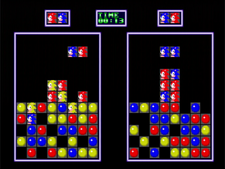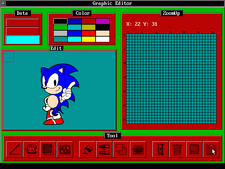Puzzle Construction[2] (パズルコンストラクション[1] Pazuru Konsutorakushon?) is a video game creation software developed by Sega in 1991. Released alongside the Sega TeraDrive hybrid Mega Drive and computer system that was developed by Sega and IBM exclusively for the Japanese market, it features three similar falling block games,[3] one of which is featuring three different colored Sonics.[4] Puzzle Construction utilizes both the IBM PC and Sega Mega Drive aspects of the TeraDrive; the software's games run on the Sega Mega Drive side of the TeraDrive, while editors and other features use the IBM PC side of the system.[2] This game is the only dedicated software released for the TeraDrive, though it also ran standard Mega Drive cartridges.
While the arcade game Rad Mobile is seen as Sonic the Hedgehog's first appearance in any video game, Puzzle Construction marks the debut of both Sonic and Dr. Eggman in the Sega home console/PC platform, as the software predates the North American release of Sonic the Hedgehog by about a month.
Gameplay[]
Puzzle Construction is software consisting of different games where players can construct their own falling-block puzzle games and play one the pre-packaged falling-block puzzle games, similar to Columns, although the pieces do not settle under gravity in Game 1 or 3, with only the Sonic pieces doing so in their respective game. All three games also feature a window on the right (1), top (2), or bottom (3) of the screen which displays the arrangement of pieces that will come next, along with having a timer that counts up to track the time spent in the specific stage. In addition to these, Games 1 and 3 have four scores are present around the main play areas:
- Score: Displays the current score.
- Speed: Displays the rate at which the pieces fall at.
- Bonus: While it is empty most of the time, this box will show the points earned upon destroying a row of pieces.
- Piece: Displays the total amount of pieces that the player has destroyed.
Game 1 also feature a Stage box which displays the current level of which the player is currently on. Each stage is beaten by clearing the bottom most row of pieces.
Upon exiting one of the games, the player is taken to a high scores screen, similar to the ones in arcades, on which they can input a three character long name to record their score. A total of ten scores are able to be recorded and displayed at once.[3]
Game 1[]
When the player selects Game 1,[3] a screen featuring a spaceship in front of a large, yellow moon is displayed until the START button is pressed a second time. The game will then appear and prompt the player to select either "GAME" or "EXIT", with the function of each being self-explanatory. Gameplay features a variety of multicolored spaceships, which disappear upon being grouped into a row of three. There are three rows of spaceships present at the bottom of the screen upon starting. A row of three spaceships will begin falling from the top of the screen, which the player can manipulate using the controller to fall where they would like. The player can also cycle the order of the ships, but they are not able to rotate said ships to be horizontal or vertical. A key factor of this particular game is that the spaceships will only disappear in horizontal, vertical, or diagonal rows; not in groups. Therefore, if the player creates a square of red ships, they will not disappear.
The game is lost when the spaceships reach the top of the screen, with the player then being prompted to enter their name into the leaderboard. Said high scores list features white text over a basic black background, featuring the points, pieces destroyed, and stage that the player reached.[5]
Game 2[]

Gameplay of Puzzle Construction's Game 2.
Upon selecting Game 2,[3] a large sprite of Sonic the Hedgehog is displayed over a bright turquoise background. The game features pairs of three differently-colored Sonics as the falling pieces. The Sonics can be rotated and will fall to the bottom, piling up. When four similarly-colored Sonics are lined up vertically or horizontally they will disappear. While these falling pieces feature Sonic, four rows of blocks are present when the game starts and are just red, blue, and yellow circles within grey borders. These circular blocks function the same as the Sonic pieces, being destroyed when connected to three or more Sonics. Upon destruction, any Sonic pieces above the removed blocks will fall down. The circular pieces are not affected by gravity under any circumstances.
The game is played against a computer opponent, with the player controlling the screen on the left.
The high scores screen features green text over a dark blue background, displaying the points, pieces destroyed, and stage that the player reached.
Game 3[]
When the player selects Game 3,[3] no loading screen appears and the gameplay screen immediately prompts the player to either "GAME" or "EXIT". This final game featured in Puzzle Construction works the same as the standard Tetris, just being flipped on its side. Here, the player directs blue shapes into the empty play area, with rows being destroyed upon them being completely filled. The background acts as a distraction with blue and empty squares being checkered in three block wide stripes. These scroll across the screen and blend in with game to confuse the player.
The player is able to rotate the pieces in order to make them fit in amongst the rows.
The score goes up with each empty row a falling piece passes when sped up by the player, and 90 points are awarded for each row destroyed.
Characters[]
Playable characters[]
- Blue Sonic the Hedgehog
- Red Sonic the Hedgehog
- Yellow Sonic the Hedgehog
Non-playable characters[]
- Dr. Eggman (first appearance)
Other modes[]
There are six different colored squares present on the main menu of Puzzle Construction, each corresponding to a different mode. The yellow square with an image of a Sega Mega Drive controller on it will take the player to the main game select screen.
The Sound Editor[6] is accessed through the green square with the three eighth notes on it, with this menu featuring two modes: B.G.M Editor and S.E Editor. The BGM Editor allows the player to listen to and edit different background tracks featured in the three games. Options such as "Tempo up" and "Repeat" are able to adjust the playback. By selecting the "File" button, the game directory can be accessed and the various in-game tracks can be selected, along with the option to play other tracks that are downloaded on the TeraDrive's drives. The tracks that are featured in the game are BGM1 through 8. The mouse curser appears as two eighth notes in this menu.

Sonic in the Graphic Editor.
The Graphic Editor[7] can be accessed by selecting the pink icon with the paint brush and paint tubes on it. It allows the player to draw over top of pre-existing graphics that are present in the game's files. A variety of tools are accessible through the bottom of the screen, and sixteen different color options chosen from the image's palette are present at the top. The "Edit" box on the left displays the full image, while the "Zoom" box on the right shows just one of 70 square selections of the graphic. The player can adjust which area is zoomed in on, and is able to edit on the 30 by 30 pixel grid. There is also a Stage Editor[8] present in the game, where the true puzzle construction takes place. Examples of the menus associated with this mode are the Layout Editor[8] and Rules Editor.[8]
Trivia[]
- Puzzle Construction is the only officially released game to feature the three differently colored Sonics, although they were also to be featured in the cancelled 1992 arcade game, SegaSonic Bros.
Gallery[]
Screenshots[]
| Gallery |
|---|
References[]
- ↑ 1.0 1.1 関連・周辺機器・テラドライブ (Japanese). Sega. Archived from the original on 14 February 2013. Retrieved on 26 January 2022.
- ↑ 2.0 2.1 The Sega TeraDrive. NFG Games. Archived from the original on 27 September 2007. Retrieved on 26 January 2022.
- ↑ 3.0 3.1 3.2 3.3 3.4 armadylo . SEGA Puzzle Construction gameplay. YouTube. Retrieved on 15 March 2022.
- ↑ Vector, Johnny (29 October 2020). Never-before-seen Sonic footage from 1991: The most obscure Sonic game ever?. Destructoid. Archived from the original on 26 January 2022. Retrieved on 26 January 2022.
- ↑ Shane McRetro (11 June 2012). Sega TeraDrive Puzzle Construction Software. YouTube. Retrieved on 15 March 2022.
- ↑ armadylo . Puzzle Construction BGM Tracks (SEGA TeraDrive). YouTube. Retrieved on 15 March 2022.
- ↑ armadylo (22 May 2020). armadylo (@armadyl01) on Twitter. Twitter. Retrieved on 15 March 2022.
- ↑ 8.0 8.1 8.2 R, Damian (23 May 2022). SUDDENデス (@suddendesu) on Twitter. Twitter. Retrieved on 15 March 2022.



